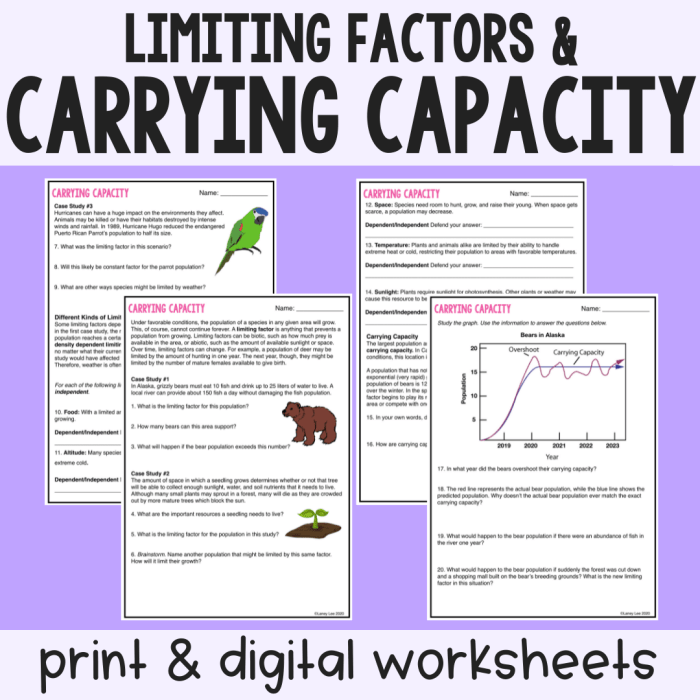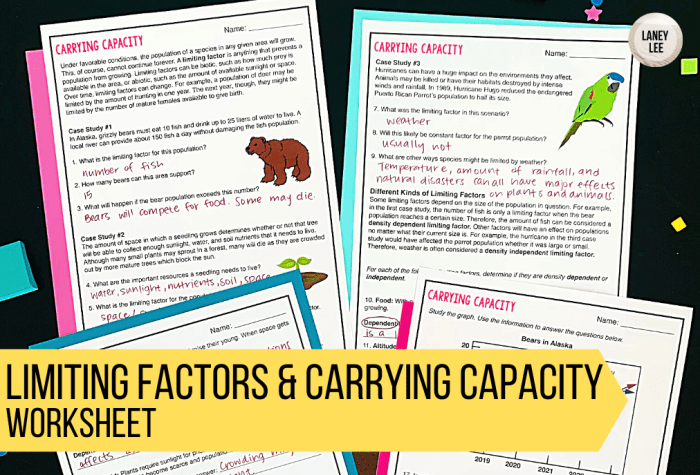Embarking on a journey into the realm of limiting factors and carrying capacity, this comprehensive guide unravels the intricate tapestry of population dynamics. By delving into the limiting factors and carrying capacity worksheet answer key, we illuminate the fundamental principles that govern the growth, regulation, and sustainability of populations.
Within this discourse, we will explore the concept of limiting factors, those environmental constraints that impede population growth. We will delve into carrying capacity, the maximum population size an environment can sustain, and its dynamic relationship with limiting factors. Through a detailed worksheet with comprehensive answer key, we will reinforce these concepts, providing a practical understanding of their implications.
Limiting Factors and Carrying Capacity

Limiting factors are environmental conditions that restrict the growth and survival of populations. They can include food, water, shelter, predators, disease, and competition. When a limiting factor is present, it prevents a population from reaching its full potential size.Common limiting factors include:
Food
The availability of food can limit population growth if it is scarce or of poor quality.
Water
Water is essential for all life, and its availability can limit population growth in arid or semi-arid regions.
Shelter
Shelter protects organisms from predators and the elements, and its availability can limit population growth if it is scarce or inadequate.
Predators
Predators can reduce population growth by killing and eating organisms.
Disease
Disease can spread through populations and reduce their size.
Competition
Competition between organisms for resources can limit population growth.
Carrying Capacity
Carrying capacity is the maximum population size that can be supported by an environment without causing degradation. It is determined by the availability of resources and the ability of the environment to absorb waste.Carrying capacity can vary depending on the environment and species.
For example, a forest can support a larger population of deer than a desert. Similarly, a population of rabbits can reach a higher carrying capacity in a field than in a forest.When a population exceeds its carrying capacity, it can lead to environmental degradation, such as overgrazing, deforestation, and pollution.
This can in turn reduce the carrying capacity of the environment and lead to a decline in the population.
Worksheet Answer Key
Question 1: What is a limiting factor?Answer: A limiting factor is an environmental condition that restricts the growth and survival of populations.Question 2: What are some common limiting factors?Answer: Some common limiting factors include food, water, shelter, predators, disease, and competition.Question
3: What is carrying capacity?Answer: Carrying capacity is the maximum population size that can be supported by an environment without causing degradation.Question 4: How can carrying capacity vary?Answer: Carrying capacity can vary depending on the environment and species.
Real-World Applications, Limiting factors and carrying capacity worksheet answer key
Understanding limiting factors and carrying capacity is important in wildlife management and conservation. By understanding the limiting factors that affect a population, wildlife managers can develop strategies to increase the population size or prevent its decline.Understanding carrying capacity is also important for human populations.
As the human population continues to grow, it is important to consider the carrying capacity of the Earth and the resources that are available to support it.Interactive ActivitiesActivity 1:Design an interactive activity or simulation that demonstrates the effects of limiting factors on population growth.Activity
2:Organize a role-playing scenario where students explore the challenges of managing resources within a carrying capacity.
Helpful Answers: Limiting Factors And Carrying Capacity Worksheet Answer Key
What are limiting factors?
Limiting factors are environmental constraints that hinder the growth or survival of a population. They can include resources such as food, water, shelter, and space, as well as biotic factors like predation and competition.
How does carrying capacity affect population growth?
Carrying capacity represents the maximum population size that an environment can sustain indefinitely. When a population exceeds its carrying capacity, resources become scarce, leading to increased competition, reduced survival, and ultimately a decline in population size.
What is the significance of understanding limiting factors and carrying capacity?
Comprehending limiting factors and carrying capacity is crucial for effective wildlife management, conservation efforts, and sustainable resource utilization. It helps us predict population trends, mitigate environmental impacts, and ensure the long-term viability of both human and natural communities.
